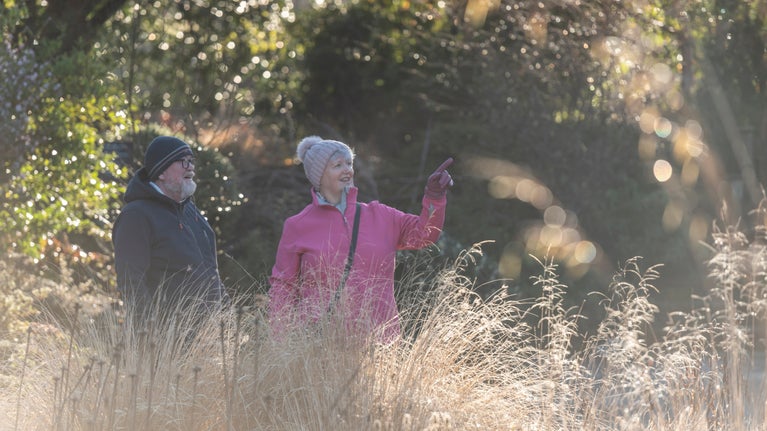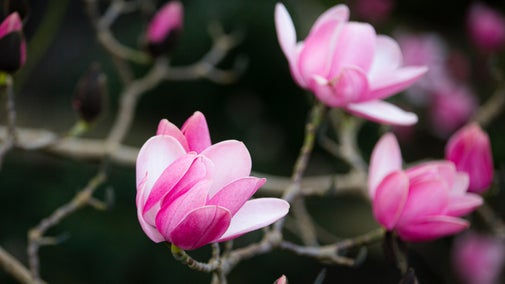
Discover more at Bodnant Garden
Find out when Bodnant Garden is open, how to get here, the things to see and do and more.

Bodnant Garden is not the work of one person, but a legacy of love by many generations of one family. Initially, a peaceful and idyllic environment in the Conwy Valley to enjoy retirement, far from the hustle and bustle of work and industry in Victorian Manchester, it became much more. Learn about the work of the Pochin and McLaren family at Bodnant, and in their working and political lives.
The founder of Bodnant Garden, Henry Pochin was a pillar of Victorian society, a captain of industry and a scientist with a passion for plants. Born in 1824, the chemist son of a yeoman farmer from Leicestershire, Henry Davis Pochin made his name, and fortune with the discovery of a distillation process to turn Victorian, brown-coloured soap to white and the production of alum cake, in great demand in the papermaking and dyeing industry.
With his early, self-made prosperity he went on to finance companies in the coal, iron and steel, engineering and shipbuilding industries. Pochin was also an aspiring politician with radical Liberal leanings and in 1852 he married Agnes Heap, herself at the forefront of the progressive movement for women’s suffrage.
From their home in Salford the couple were active in their community working to improve the lives of working people, Pochin serving as councillor and later mayor.

At the time of her marriage Agnes was already a figure in the suffrage movement. In 1853 she attempted to persuade MP John Bright to include a suffrage clause in his Reform Bill of 1853 and in 1855, under the name Justitia, she published The Right of Women to Exercise the Elective Franchise.
In 1868 she addressed a ground-breaking public meeting at Manchester Free Trade Hall, chaired by her husband, out of which the Manchester National Society for Women’s Suffrage was born. The following year Agnes and Henry organised a petition in Salford, because of which 1,248 women were added to the Salford parliamentary register.
After many industrious years in Manchester the couple retired to Bodnant Garden, North Wales, in 1874, where Pochin set about remodelling Bodnant Hall and developing the gardens to display his collection of exotic trees and shrubs. He enlisted the skills of famous landscape designer Edward Milner to develop the formal Victorian shrub garden around the house, including the Laburnum Arch.
Pochin was also the driving force behind the development of the riverside gardens, supervising the planting North American conifers, and a massive project of rock works to re-enforce banks and waterways, and create paths forming the romantic dell walks.
As a local landowner Pochin was no less active, building cottages on the Bodnant estate and improving farming practices. He also bought land at nearby Prestatyn on the North Wales coast, where he supplied the seaside town with clean water and gas, built flood defences and developed a foreshore with promenade.
Pochin went to become Justice of the Peace, Deputy Lieutenant and Sherriff of Denbighshire and remained active in business during the 1880s. Agnes continued to fight the suffrage cause, serving on the Central Society for Women’s Suffrage, and supporting the work of her daughter Laura.
Henry died in 1895 and Agnes passed away in 1908.
Laura Pochin shared her father’s passion for the garden and her mother’s support and work in the suffrage movement. Laura continued the work in the riverside garden after her father’s death, developing the wild garden and arboretum in the Far End.
The Pochin and McLaren families came to know each other through famed Liberal politician John Bright’s friendship with Henry Pochin. John’s sister, Agnes, was married to Duncan McLaren and was also a tireless campaigner for the cause of women's suffrage.
The families were united when, in 1877, Priscilla and Duncan McLaren's son, Charles, married Henry and Agnes’s daughter, Laura. Charles, a Scottish barrister and an MP for Stafford and Bosworth, was made a peer in 1911 and chose the title Lord Aberconway, which means 'mouth of the river Conwy’ in Welsh.
As the children of campaigning parents, both Laura and Charles were aware from an early age of the suffrage cause and continued to instil in their children and grandchildren the importance of being an advocate for women’s rights.
Laura also continued her mother's campaigning work for the suffrage movement. Laura argued that all women must be allowed to take their rightful place as full citizens in political life for the nation to prosper.
– Laura McLaren, The Academy (September 1908)
Laura shone a light on the sexual abuse of girls and young women, raising a topic not normally talked about in polite society, and championed an end to White Slave Trafficking. In 1912 Laura lobbied for the White Slave Traffic Bill to crush the procurement of girls for prostitution. She also recognised that without a vote many of her sex were relegated to a kind of slavery, at home and in the workplace.

Laura believed that believed that supporting women was key to keeping a nation in good health, from cradle to grave. It took more than 60 years of 'spade-work' by three generations of the family to secure the passage of the Representation of the People Act in 1918. Family matriarchs Agnes and Priscilla did not live to see that day, but Laura and her daughters did.
Laura’s son, Henry, followed in his father’s footsteps and served as Liberal MP for West Staffordshire and Bosworth. He went on to captain the family businesses, however, the 2nd Lord Aberconway's great love was the garden at Bodnant.
Henry’s crowning achievement was the design and construction of the five terraces, a project given to him by his mother, Laura. He had a passion for exotic new trees and shrubs being discovered in Asia and the Americas. He was also president of the Royal Horticultural Society from 1931 until his death.
In 1948 he persuaded the National Trust to accept gardens on their own merit into the fold of the charity with Bodnant being the second admitted in 1949 after Hidcote. When Henry died in 1953, his son Charles inherited the title of 3rd Lord Aberconway and the care of Bodnant estate and garden.
Over the course of another half century, Charles continued to develop Bodnant Garden with the National Trust, making improvements, opening new vistas, and adding new plants.
Like his father, he served as president of the RHS (Royal Horticultural Society) from 1961 until 1984. His son Michael McLaren inherited the estate in 2003 on his father’s death and plays an active role to this day, as garden director, maintaining the family's cherished connection to Bodnant Garden.
For 85 years the development of Bodnant Garden was a family affair, a partnership between the McLarens and their head gardeners, the Puddles.
Frederick Puddle arrived at Bodnant as head gardener in 1920 and it was the start of a new chapter for the garden. A talented horticulturalist, he shared his passion for plants with the 2nd Lord Aberconway, who was an active sponsor of global botanical expeditions.
With this influx of exotic new plants from Asia and South America they transformed the garden. They also worked closely together on the garden’s plant breeding programme producing many hybrids, especially rhododendrons, from these new plant discoveries. Frederick's skill took Bodnant Garden to gold success at several Chelsea Flower Shows and he was awarded the RHS Victoria Medal of Honour alongside his employer.
From 1947 Frederick's son Charles followed in his footsteps to become head gardener and was also awarded the RHS Victoria Medal of Honour for his horticultural achievements. Charles Puddle was at the helm when Bodnant Garden was given into the care of the National Trust in 1949.
Charles and his son Martin, who went on to be head gardener from 1982, steered Bodnant through this new era, during which time it became one of Britain's most famous gardens. The long family link was only broken when Martin died in 2005. The Puddle Garden close to our Visitor Welcome Centre was created in 2011 in tribute to these three men and is filled with the plants which they loved.

Find out when Bodnant Garden is open, how to get here, the things to see and do and more.
Discover how a 'dwelling by a stream' in Snowdonia's foothills grew into a global horticultural haven thanks to generations of the McLaren family and Puddle head gardeners.

Enjoy delicious refreshments at Bodnant Garden’s cafes and kiosk all year round or pick up a plant, gift or an exciting pre-loved read to take home.

Explore the many exotic and rare plants and trees at Bodnant Garden, including five National Collections, as well as Wales’s largest collection of UK Champion Trees.

With 80 acres to explore, there's a walk to suit everyone. From 1 October to the end of March 2026, dogs are welcome every day on short leads (not extendable). Find out more about bringing your dog to Bodnant Garden here.
